コラム
落合憲弘
John Sypal
タカザワケンジ
なぎら健壱

A draw for both the faithful and simply curious, the Ushiku Daibutsu is a colossal, 120-meter-tall statue of Amitabha Buddha that rises from the rural landscape. Located about an hour and a half northeast of Tokyo in Ibaraki prefecture, this Daibutsu is, for one reason or another, generally less known than the much smaller, and far older (and seated) Buddha statues located in Kamakura and Nara. (Indeed, either of those is said to be able to fit in the palm of its hand.)
The center point of a spacious and modern temple complex, an 800 yen entrance fee grants visitors access to the grounds (which include flower beds, koi ponds and a petting zoo) and the chance to go on in and up into the statue itself. After viewing a somewhat new-agey yet sincere explanation at the entrance, visitors (carrying their shoes held in plastic bags) wind their way through rooms of displays about the statue’s construction and take an elevator up to the highest accessible floor. From its the lookout windows in the Daibutsu’s chest you can look out across the Kanto plain and see Tokyo’s skyline and Mt. Fuji on the western horizon.
Within the structure is a Buddhist temple with several thousand smaller golden Buddha statues. (A desk nearby has staff on hand to answer questions about the availability of the temple’s cemetery plots.) Finally, like many religious sites around the world, all visitors exit through a gift shop. It was there on a recent visit (my second in twenty years) that I spotted a stack of photobooks on a shelf in the corner. The black and white cover caught my eye- and, flipping through the sample copy, its specificity caught my interest. Seeing the marked-down price – a mere 500 yen?- sealed the deal.
The book’s subtitle states that it is a record of the Ushiku Daibutsu’s construction- something which, after four and a half years, ended in 1993. Until 2008 the it held the title (and Guiness Record, something which is also on display inside), as being largest statue in the world. Currently it is in 5th largest, but remains #1 in the Bronze statue sub-category.
Back to the photobook. This B5 sized softcover is a compilation of pictures taken by three Ibaraki women: Yoshiko Arumi, Kithii Ushiku, Toshiko Ohtani. Photo-credits aren’t provided for individual pictures and as far as I can determine, this remains their only publication. Interestingly, the book was originally published in 2007- almost fifteen years after the last piece of bronze was welded down. (My copy is from the third print run in 2015.)
The book is divided into three general parts.
The first- and longest- collects photographs of the statue under construction, with the photographer enjoying the spectacle with her telephoto lens and enviable access to the site. Since sections of the statue were pre-assembled on the ground before being lifted into reassembled into place, she (which lady, it is never said) was able to capture photographs which at times suggest the illogical multi-views of collages. A giant hand here, some toes there- above, crane beams and cable allow sections of the statue’s serene face float up to their planned position.
The second part of the book explores the way the completed Ushiku Daibutsu interacts with the local landscape. As the statue in its grainy silver sfumato looms on the distance over rice fields and village roofs in these pages I can’t help but feel an echo of Japanese giant-monster kaibutsu movies. These pictures are clever- and are, in their own way, far different than the crisp, vivid color photographs of the statue which appear on the calendars and postcards offered for sale in the gift shop. There’s a sense of enjoyment in them that I find quite appealing.
The final section is a more (literal) nuts & bolts approach: First, a field is cleared. The pedestal is built. Dutifully, the photographer then straightly recorded each major part of the statue’s assembly, feet to head. No clever games here- just the kind of descriptive progress-reportage pictures that construction companies- in this case, Kawada Technologies Inc.- use to document their work.
Taken together, The Sudden Appearance of the Ushiku Daibutsu is half documentary, half construction-site progress report, and half amateur local photographer album- this calculation which adds up to a somewhat quirky but lovingly earnest celebration of a local landmark.
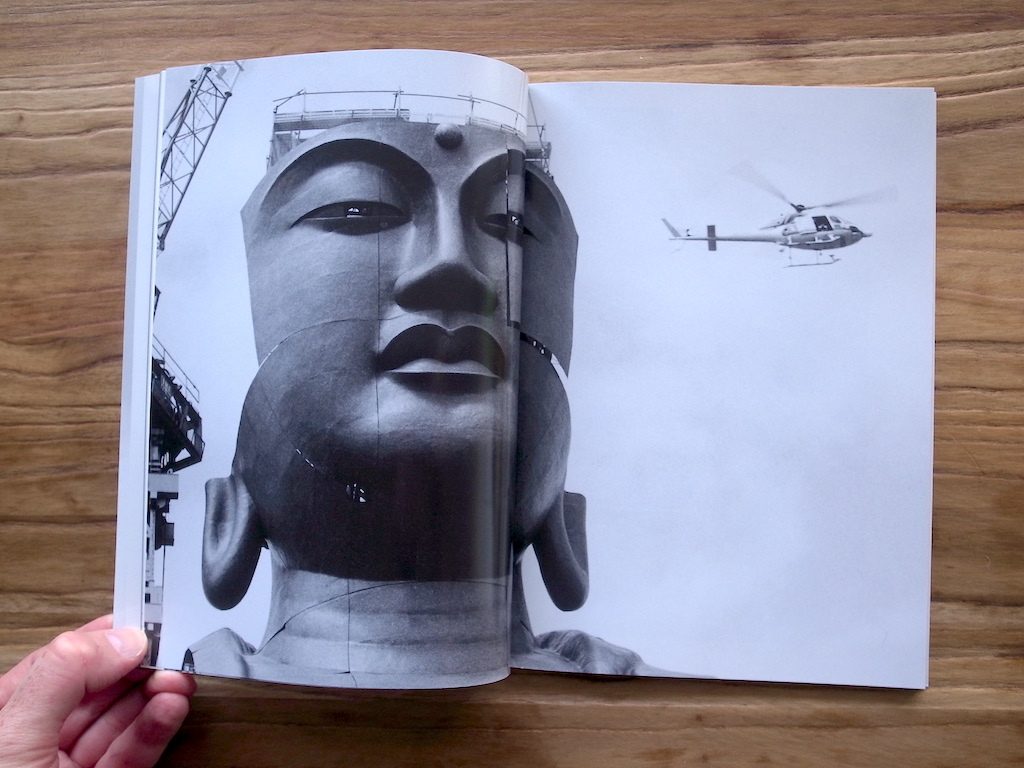
「牛久大仏」は田園風景の中にそびえ立つ、高さ120メートルの巨大な阿弥陀如来像です。東京から北東へ約1時間半、茨城県牛久市にあるこの大仏は、鎌倉や奈良にある小さくて古い座像の大仏よりと比べると、一般にはあまり知られていないように感じます。
広々とした近代的な寺院の中心に位置する牛久大仏は、800円の入場料で境内、そして胎内にも入ることができます。入口には新しめで丁寧な案内文が掲示されており、訪問者は(靴をビニール袋に入れたまま)像の建設に関する展示の部屋を通り、エレベーターで大仏胎内を上がります。大仏の胸にある展望窓からは、関東平野を見渡すことができます。天気がよければ西の地平線には東京のスカイラインと富士山が見えることでしょう。施設の中の仏教寺院には数千体の小さな黄金の仏像があります。近くにあるデスクには、寺院の墓地区画の空き状況についての質問に答えてくれるスタッフが待機しています。ツアーの最後は、世界中の多くの宗教施設がそうであるように、訪問者はギフトショップ(お土産物屋さん)さんから外へ出ます。
実は最近、20年ぶり2度目の牛久大仏へ訪れた際、私は売店の隅の棚に積まれた写真集を見つけました。白黒の表紙に目を奪われ、見本をパラパラとめくってみると、その具体性に興味を引かれました。そしてわずか500円という値札を見て、すぐに買うことを決めました。
「世界一の阿弥陀像完成までの1765日を記録」と副題にあるように、牛久大仏のは4年半という歳月を経て、1993年に完成しました(ちなみに2008年まで牛久大仏は世界最大の像の称号を保持していたそうです。現在は第5位ですが、ブロンズ像のカテゴリーでは第1位を維持しています)。つまりこの写真集は建設記録集でもあるのです。
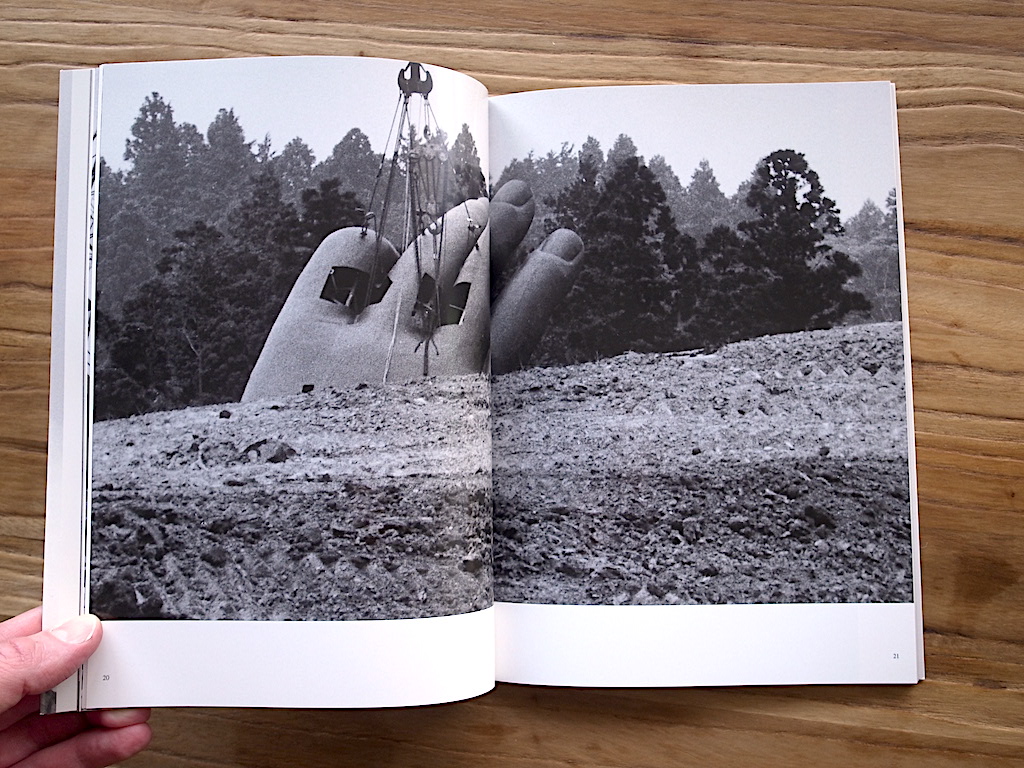
作者は著名なカメラマンによるものではなく、荒海美子さん、牛久きちいさん、大谷淑子さんという茨城県に住むの3人の女性です。個々の写真にクレジットは書かれておらず、私が知る限りこれはこの彼女たちの唯一の出版物です。この本の初版は2007年ですが、私が買った一冊は2015年に増刷された第3刷です。
本書は大まかに3つのパートに分かれています。
本書で最もボリュームのある最初のパートは、大仏の建設過程の写真を集めたもので、写真家は望遠レンズと現場へのアクセスを駆使してその光景を楽しんでいます。
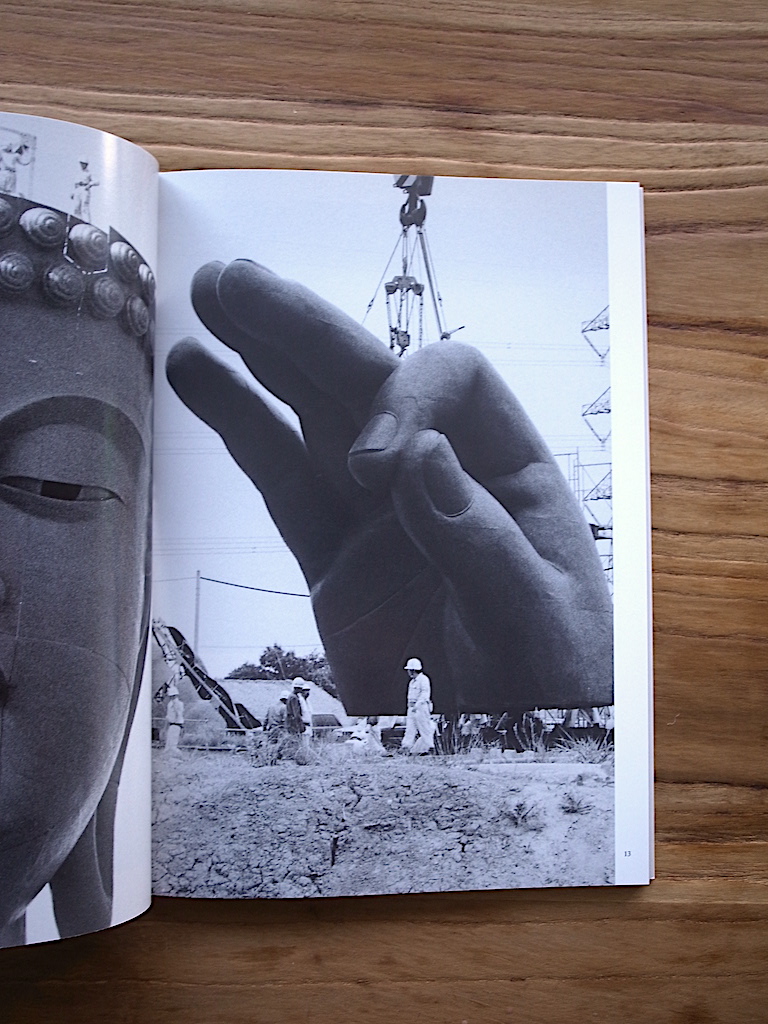
像の各部分は、持ち上げられ所定の位置に組み直される前に、地上であらかじめ組み立てられていたため、写真家(どの写真家かは語られていない)は、時にコラージュの非論理的な多視点を示唆する写真を撮影することができました。
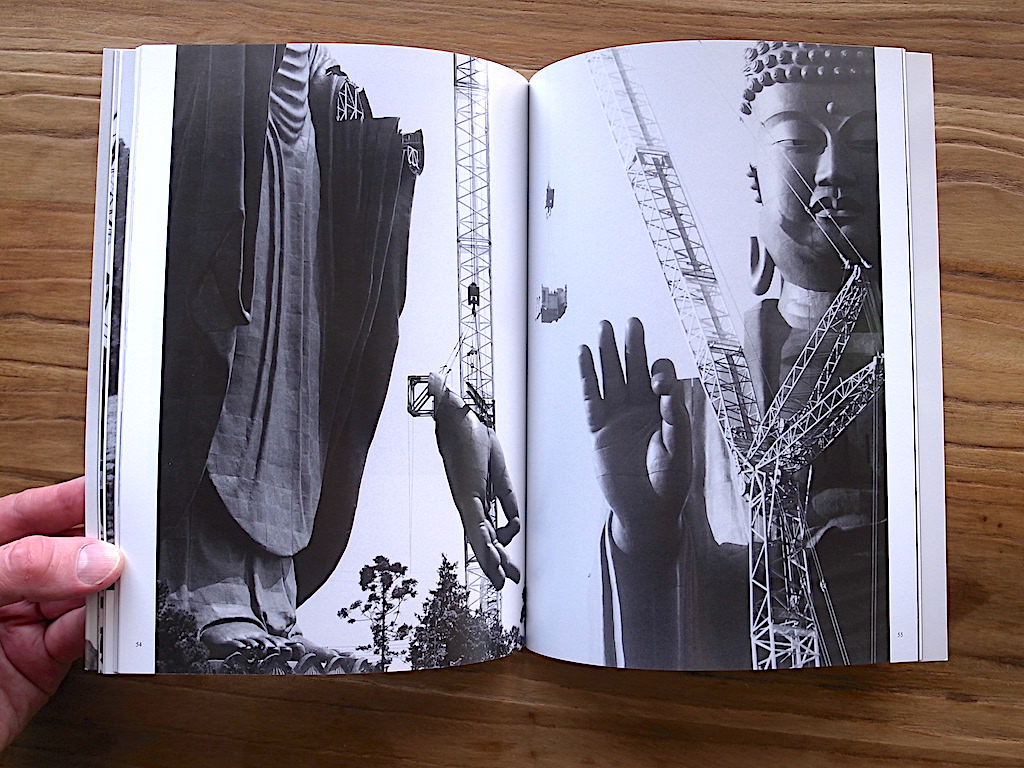
クレーンの梁とケーブルによって、大仏の穏やかな顔の一部が予定された位置まで浮かび上がったり、つま先がまったく違う位置にあったり。少しシュールで面白いです。
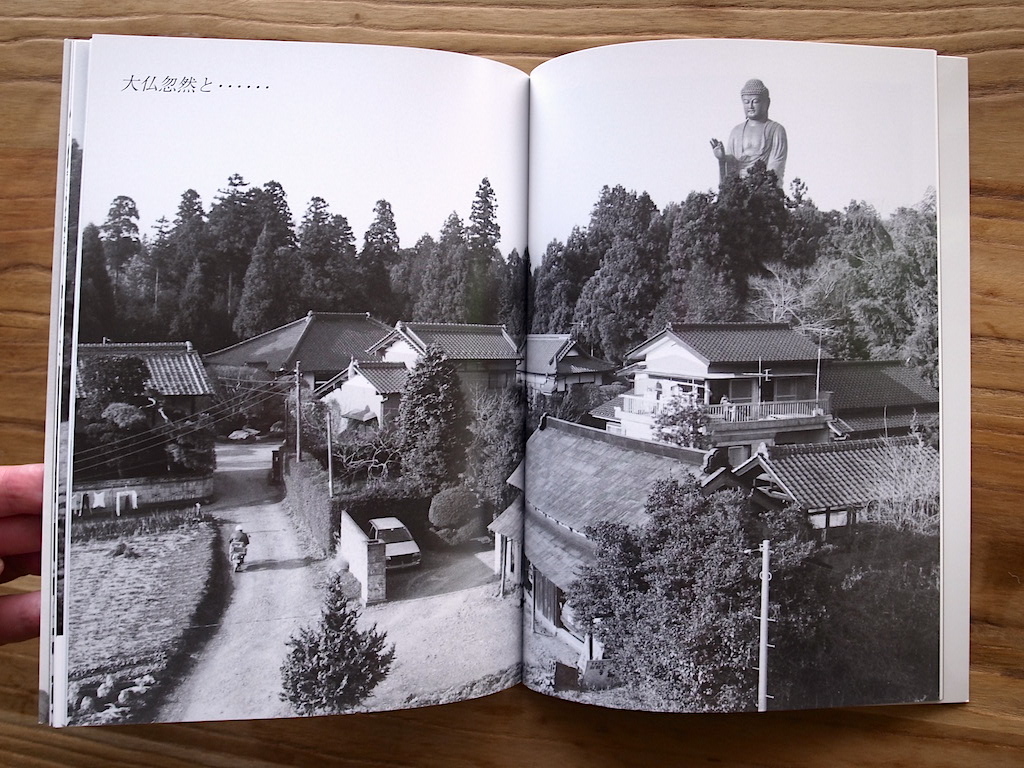
2つ目のパートでは、完成した牛久大仏が地元の風景とどのように関わっているのかを探る写真群です。粒状の銀色の諧調をまとった牛久大仏が、田んぼや村の屋根の向こうに遠くのほうまで迫ってくるこのページには、日本の巨大怪獣映画の雰囲気を感じずにはいられません(映画「ゴジラ」やアニメ「新世紀エヴァンゲリオン」の見過ぎでしょうか?)。
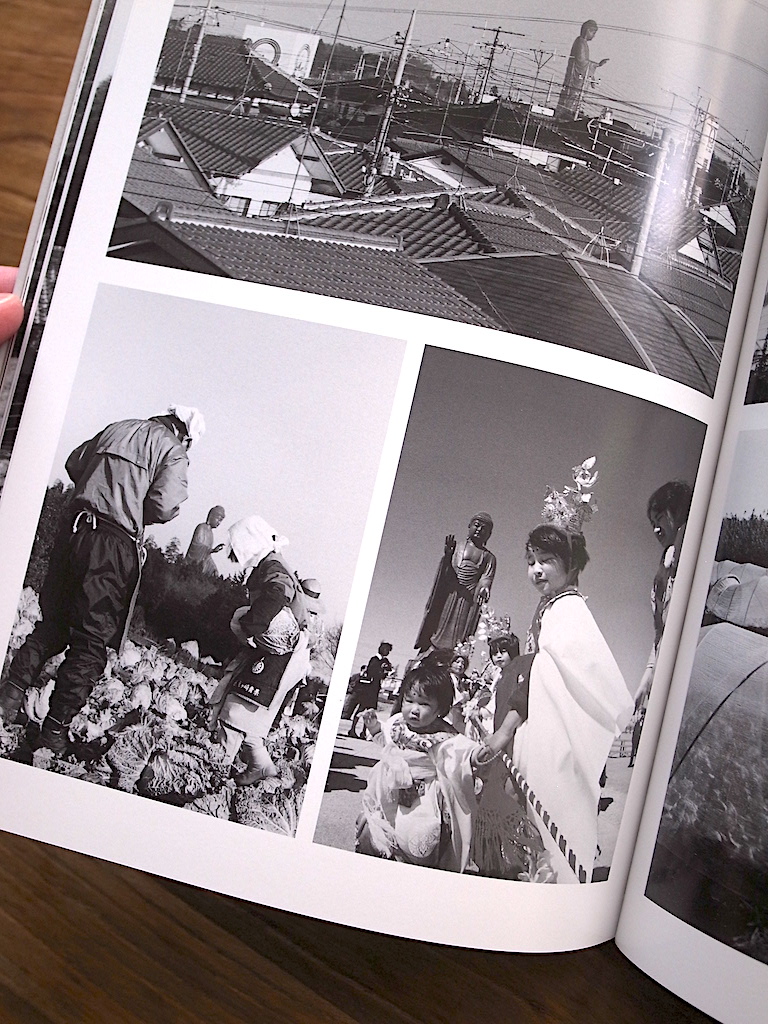
これらの写真は技法的にも、よく売店などで目にするカレンダーやポストカードに掲載されている鮮明なカラー写真とは一線を画しています。楽しげな雰囲気があり、とても魅力的です。
最後のセクションは、よりストレートで、3人の写真家の地道なアプローチの集成です。畑に台座が作られれ、像の組み立ての主要な部分を、足から頭までまっすぐに記録したシリーズです。そこに巧みな駆け引きはなく、建設会社によるな進捗報告のような、定点写真です。
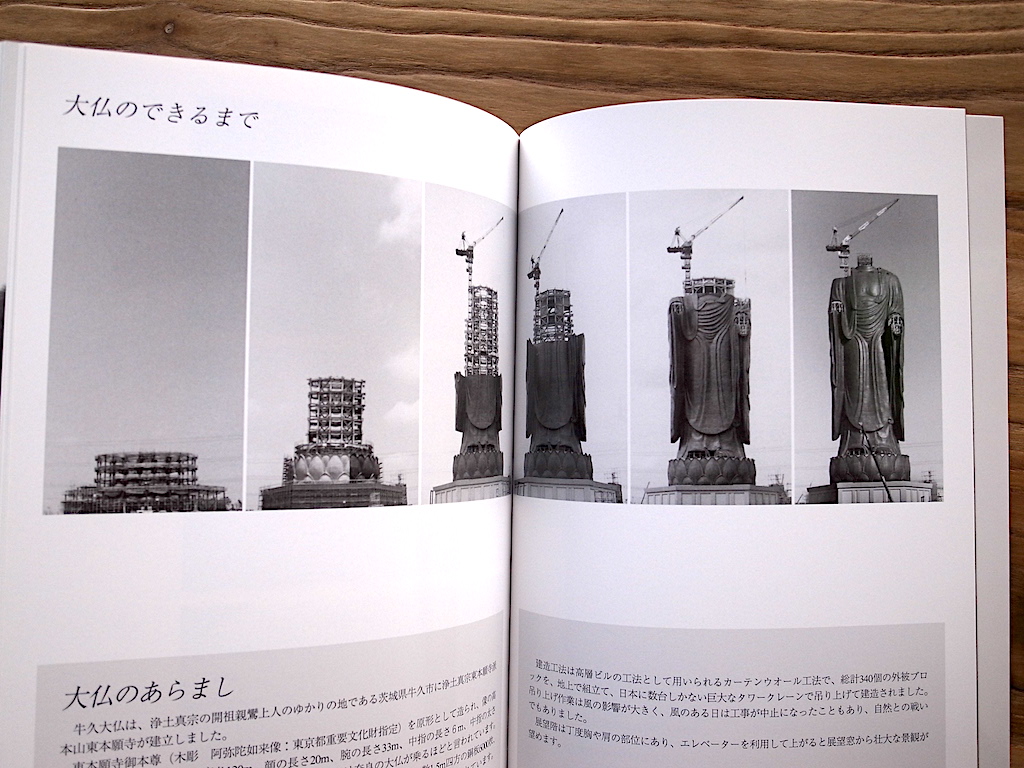
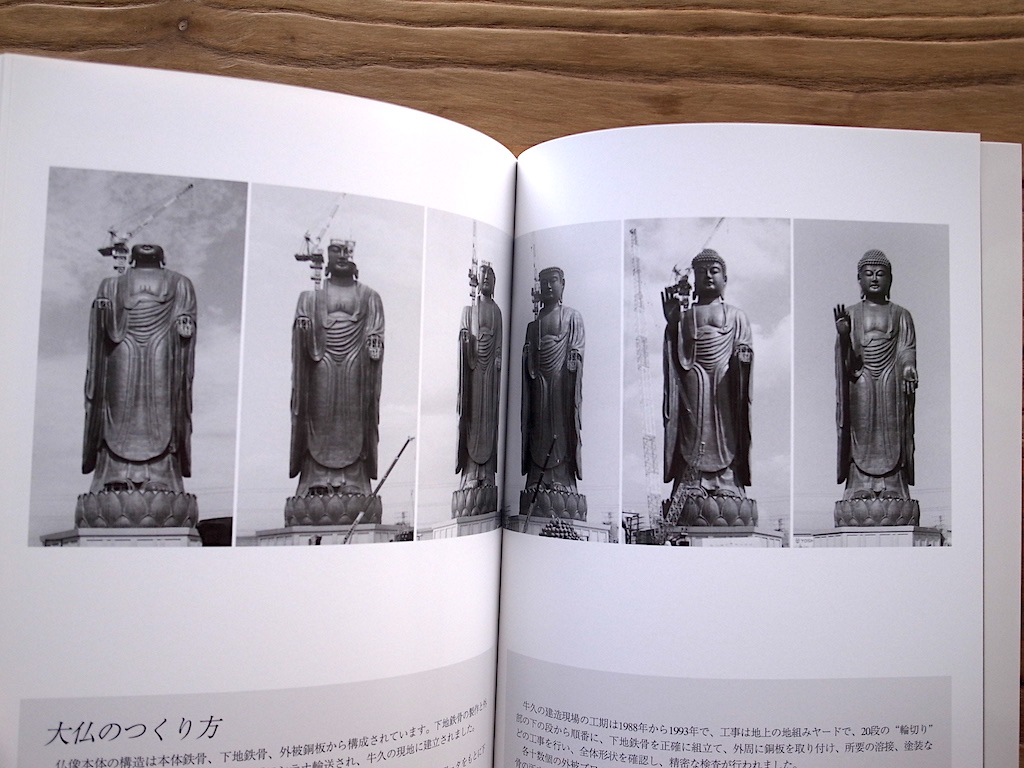
写真集『牛久大仏忽然の貌』は、ドキュメンタリーであり、工事現場の経過報告であり、そしてアマチュア写真家のアルバムでもあります。やや風変わりな地元の名所を、愛情を込め真摯に祝うことに繋がっていると感じる一冊です。
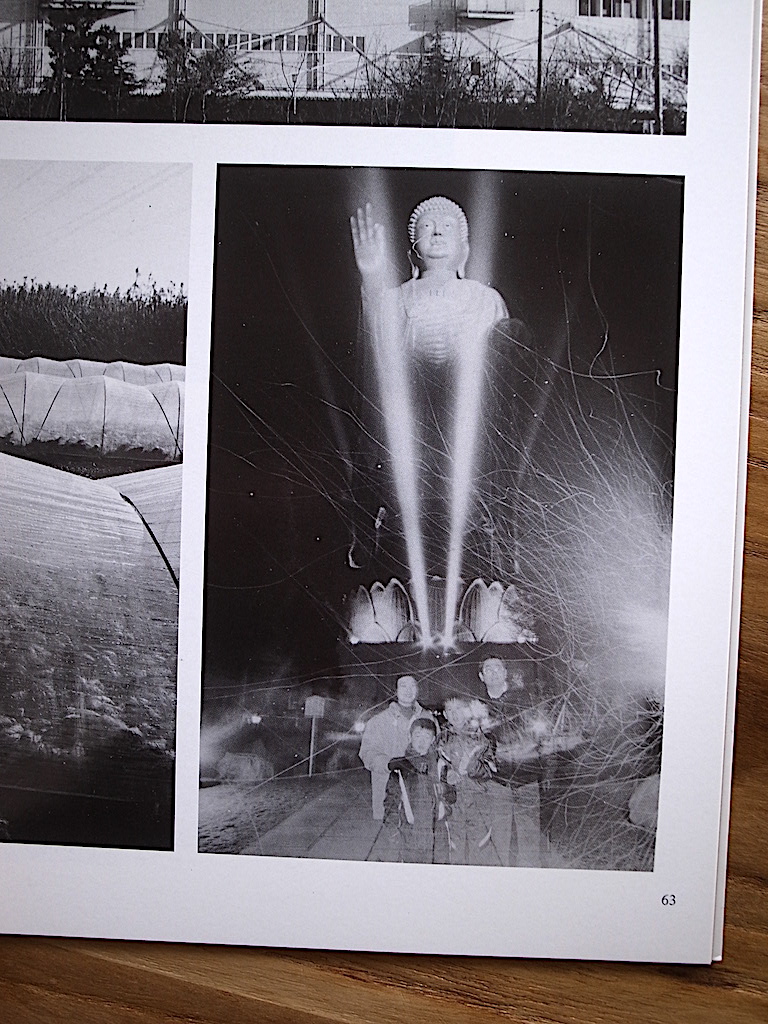
- "The sudden appearance of the Ushiku Daibutsu :A 1765 day diary of the completion of the world’s largest Amida statue"
- By Yoshiko Arumi, Kithii Ushiku, Toshiko Ohtani
- 『牛久大仏忽然の貌|世界一の阿弥陀像完成までの1765日を記録』
- 著者:荒海美子、牛久きちい、大谷淑子
- 発行:光村印刷
- 発行日:200年9月20日
- https://www.amazon.co.jp/牛久大仏忽然の貌―世界一の阿弥陀像完成までの1765日を記録-荒海美子・牛久きちい・大谷淑子写真集-BeeBooks-荒海-美子/dp/4896159969


PCT Membersは、Photo & Culture, Tokyoのウェブ会員制度です。
ご登録いただくと、最新の記事更新情報・ニュースをメールマガジンでお届け、また会員限定の読者プレゼントなども実施します。
今後はさらにサービスの拡充をはかり、より魅力的でお得な内容をご提供していく予定です。
 「Photo & Culture, Tokyo」最新の更新情報や、ニュースなどをお届けメールマガジンのお届け
「Photo & Culture, Tokyo」最新の更新情報や、ニュースなどをお届けメールマガジンのお届け 書籍、写真グッズなど会員限定の読者プレゼントを実施会員限定プレゼント
書籍、写真グッズなど会員限定の読者プレゼントを実施会員限定プレゼント